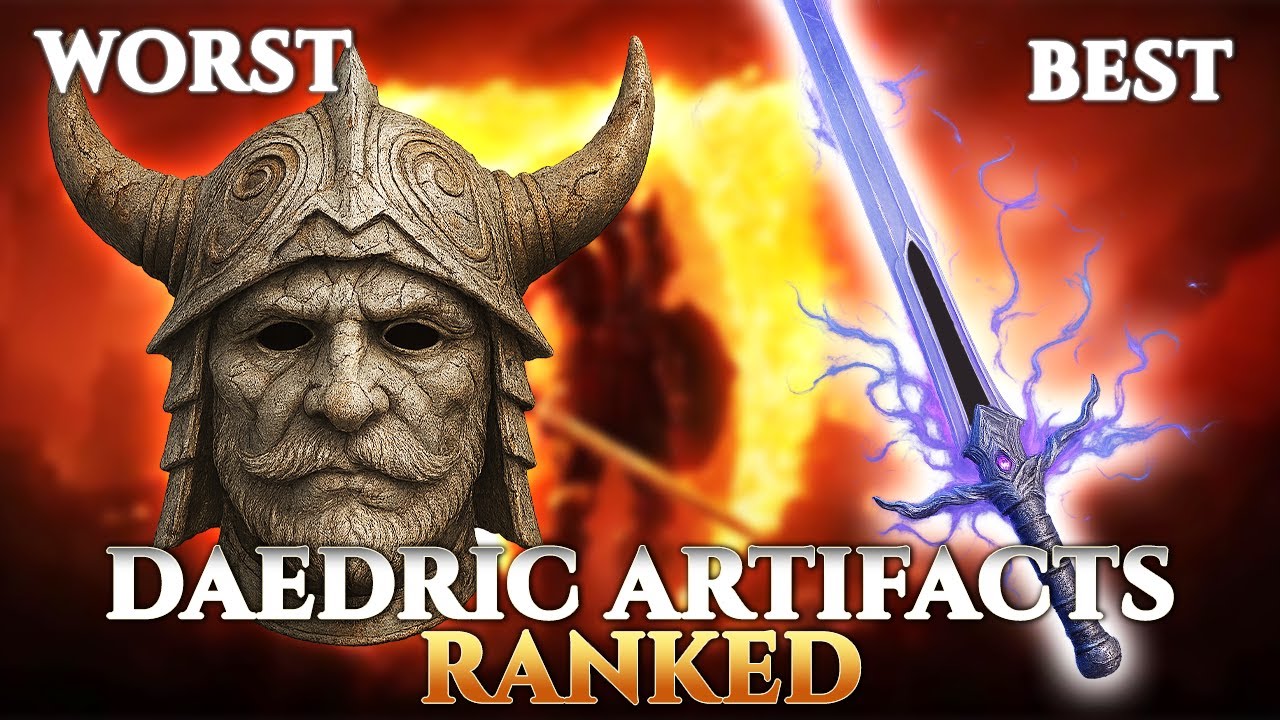The Elder Scrolls IV: Oblivion Remastered, released on April 22, 2025, for PC, PS5, and Xbox Series X|S, breathes new life into Bethesda’s 2006 RPG with Unreal Engine 5 visuals and refined mechanics, while preserving the open-world magic that defined Cyrodiil. As you battle the Mythic Dawn and close Oblivion Gates, Daedric Artifacts—unique items granted by the 15 Daedric Princes through their shrine quests—offer powerful tools to shape your playthrough. From weapons to armor to utility items, these artifacts range from lackluster to game-changing, depending on your build and playstyle. However, the main quest “Blood of the Daedra” requires sacrificing one, making it crucial to know which are worth keeping. Drawing from player insights and the remaster’s updates, here’s every Daedric Artifact in Oblivion Remastered ranked from worst to best, with tips on how to get and use them effectively.

15. Sanguine Rose (Sanguine)
Obtained at level 8 from Sanguine’s shrine southeast of Cheydinhal, the Sanguine Rose is a staff that summons a random Daedra for 20 seconds to fight a target. While the quest—involving crashing a dinner party with a Stark Reality spell—is delightfully chaotic, the staff’s unreliability makes it the weakest artifact. The summoned Daedra, ranging from weak Scamps to powerful Xivilai, isn’t allied with you and may attack anyone, including you or allies. With only 10 charges, it’s a gamble in combat, often causing more trouble than it’s worth. For mages, custom Conjuration spells are more consistent, and warriors or thieves find little use for it. Sacrifice this in “Blood of the Daedra” without hesitation, as its novelty fades fast.
14. Masque of Clavicus Vile (Clavicus Vile)
Clavicus Vile’s quest, available at level 20 southwest of the Imperial City, offers the Masque or the Umbra sword. Choosing the Masque, a heavy armor helmet, grants +20 Personality, aiding persuasion and merchant interactions. However, its steep cost—surrendering Umbra, one of the game’s best weapons—makes it a poor choice. Personality can be boosted via Speechcraft, Charm spells, or potions, rendering the Masque situational. Heavy armor users might value its defense, but lighter helmets like the Fin Gleam offer better utility. The quest is engaging, involving a moral dilemma with Barbas, but the Masque’s limited impact and high price land it near the bottom. Give this to Martin if you accidentally choose it.
13. Ring of Namira (Namira)
Namira’s shrine, east of Bruma, unlocks at level 5 for characters with low Personality (20 or less). The quest requires casting a spell to extinguish priests’ torches in Anga, letting Namira’s followers kill them. The reward, the Ring of Namira, provides 12% Reflect Spell and 10% Reflect Damage. While decent for mage-heavy fights, these effects are outclassed by custom enchantments or items like the Mundane Ring. The ring’s low stats and niche use make it forgettable, especially since Reflect Spell potions are widely available. Unless you’re role-playing a cannibalistic build, as some players jest, this artifact is a safe sacrifice for “Blood of the Daedra,” offering little beyond trophy value.
12. Wabbajack (Sheogorath)
Sheogorath’s level 2 quest, near the Elsweyr border, tasks you with fulfilling a doom prophecy in Border Watch, a quirky romp involving cheese and sheep. The Wabbajack staff transforms non-humanoid enemies into random creatures for 10 seconds, embodying the Madgod’s chaos. It can turn a Daedroth into a sheep, easing fights, but might also create a troll, restoring the enemy’s full health if not defeated quickly. With 10 charges, it’s a fun but impractical toy, useless against humanoids like bandits. Mages prefer reliable spells, and melee builds carry better weapons. Its iconic status in Elder Scrolls lore adds charm, but it’s a prime candidate for Martin’s ritual due to its situational nature.
11. Skull of Corruption (Vaermina)
Vaermina’s level 5 quest, west of Cheydinhal, sends you to Arkved’s Tower to steal a dream orb, facing monsters or sprinting past them. The Skull of Corruption staff creates a 30-second clone of a humanoid target to fight its double, with 20 charges. It’s effective against tough NPCs, like guards, as clones mimic their gear, but counts as assault, risking bounties. It doesn’t work on creatures, limiting its scope, and mages can replicate similar effects with Illusion spells. The remaster’s ragdoll bugs in Shivering Isles make clones occasionally unusable, further reducing its value. While fun for chaos, it’s not essential and can be sacrificed if needed.
10. Mace of Molag Bal (Molag Bal)
Molag Bal’s level 17 quest, west of Lake Rumare, involves tricking Melus Petilius into killing you with a Cursed Mace, requiring a lion pelt offering. The Mace of Molag Bal absorbs 10 points of Strength and Magicka for 10 seconds per hit, fixed in the remaster to make the Strength effect functional. It’s decent for hybrid caster-melee builds, weakening warriors and mages alike, but its low damage (one less than a Daedric mace) and 16 charges limit its appeal. Blunt-focused characters might use it briefly, but custom-enchanted weapons outperform it. Sacrifice it if you favor other weapons, as its utility is niche.
9. Volendrung (Malacath)
Malacath’s level 10 quest, west of Anvil, tasks you with freeing ogres from Bleak Mine, requiring a troll fat offering. Volendrung, a two-handed warhammer, has Paralyze for 3 seconds and Drain Health 5 points, with 16 charges. Its high damage suits Blunt warriors, but its heavy weight (heavier than a Dwarven warhammer) slows movement, and paralysis is available via poisons. The remaster’s updated physics make its swings feel weighty, but it’s impractical for non-Blunt builds or light armor users. Keep it for heavy-hitting playstyles, but consider sacrificing it if you prefer agility or ranged combat.
8. Saviour’s Hide (Hircine)
Hircine’s level 17 quest, south of Cheydinhal, requires a wolf or bear pelt and tasks you with killing a unicorn in Harcane Grove—a tough foe that can be ridden if not attacked. The Saviour’s Hide, a light armor cuirass, offers 25% Resist Magic and 11 defense. It’s ideal for light armor users, especially Altmer or Apprentice birthsign characters, but its enchantment is modest compared to items like the Ayleid Crown of Lindai. The remaster’s visuals make its bestial design pop, but its mid-tier stats mean it’s replaceable. Sacrifice it if you have better armor, but keep it for early-game magic resistance.
7. Ebony Blade (Mephala)
Mephala’s level 15 quest, northeast of the Imperial City, involves sowing discord in Bleaker’s Way, requiring a nightshade offering. The Ebony Blade, a one-handed katana, absorbs 10 points of Health and Silences enemies for 10 seconds, with unlimited charges. Its health drain sustains warriors in prolonged fights, and Silence cripples mages. While not the strongest katana, its uncharged enchantment makes it reliable for melee builds. The remaster’s combat tweaks enhance its fast swings, but its base damage is moderate. Keep it for hybrid or blade-focused playstyles, but it’s expendable for archers or pure mages.
6. Spell Breaker (Peryite)
Peryite’s level 10 quest, west of Bravil, sends you to an Oblivion plane to save his five followers’ souls, no offering needed. Spell Breaker, a heavy shield, provides 30% Reflect Spell, countering mages and magical enemies like Will-o-the-Wisps. Even non-shield users can equip it for its enchantment, making it versatile. Its Orcish-level defense is solid, but heavy armor skill is needed to wield it comfortably. The remaster’s updated lighting makes its Dwemer design shine. Keep it for mage-heavy areas like Ayleid ruins, but sacrifice it if you rely on two-handed weapons or stealth.
5. Goldbrand (Boethia)
Boethia’s level 20 quest, east of Kvatch, requires a Daedra Heart and pits you against champions in the “Tournament of Ten Bloods” in an Oblivion plane. Goldbrand, a one-handed katana, deals high fire damage, shredding undead or frost-resistant foes. Its golden design and reliable damage make it a top melee weapon, though it requires recharging. The remaster’s combat tweaks make its swings fluid, ideal for warriors or spellswords. Pair it with Azura’s Star for endless charges. Keep it for high-damage builds, but sacrifice it if you favor stealth or magic over melee.
4. Ring of Khajiiti (Meridia)
Meridia’s level 10 quest, west of Skingrad, involves clearing necromancers from Howling Cave, requiring an undead offering (Bonemeal, Ectoplasm, or Mort Flesh). The Ring of Khajiiti grants 35% Chameleon and +10 Speed, boosting stealth and mobility. While not full invisibility, stacking Chameleon with other items can make you nearly undetectable, perfect for thieves or assassins. The speed boost aids exploration and dodging. Its versatility suits any build, especially early-game stealth characters. Keep it for sneaking past guards or pickpocketing, but sacrifice it if you prioritize combat artifacts.
3. Oghma Infinium (Hermaeus Mora)
Hermaeus Mora’s level 20 quest, unlocked after all 14 other Daedric quests, requires trapping souls of all 10 races using a special soul gem and spell, with no offering needed. The Oghma Infinium, a book, permanently boosts three attributes and three skills by 10 points, depending on your choice (Path of Steel, Shadow, or Spirit). Its late-game availability reduces its impact, but it’s a permanent power-up for any build. The remaster’s streamlined leveling makes its boosts more noticeable. Keep it for optimizing high-level characters, but sacrifice it if you’ve maxed your key stats.
2. Azura’s Star (Azura)
Azura’s level 2 quest, north of Cheydinhal, requires a glow dust offering and tasks you with clearing vampires from Gutted Mine. Azura’s Star, a reusable Grand Soul Gem, captures souls to enchant or recharge weapons, saving gold and effort. It’s invaluable for enchanters, mages, or anyone using enchanted gear, pairing perfectly with weapons like Umbra. The remaster’s updated enchanting UI makes it even smoother to use. Its early availability and universal utility make it a must-keep, despite the main quest nudging you to sacrifice it. Never give it to Martin—its value is unmatched.
1. Skeleton Key (Nocturnal)
Nocturnal’s level 10 quest, north of Leyawiin, involves retrieving the Eye of Nocturnal from thieves, requiring no offering. The Skeleton Key, an unbreakable lockpick, boosts Security by 40, trivializing lockpicking with spam-able auto-pick. It’s a godsend for thieves, assassins, or any build, removing the frustration of broken picks and tricky tumblers. The remaster’s updated lockpicking minigame remains challenging without it, making the Key a lifesaver. Its utility persists across the entire game, from looting chests to accessing guild quests. Never sacrifice it to Martin—its ease and versatility make it the best Daedric Artifact.
Why These Rankings Matter
The rankings reflect each artifact’s utility, combat impact, and relevance across playstyles in Oblivion Remastered. S-tier artifacts like Skeleton Key and Azura’s Star offer universal benefits, easing lockpicking and enchanting for all builds. A-tier items like Oghma Infinium, Ring of Khajiiti, and Goldbrand excel for specific roles—stat boosts, stealth, or melee. B-tier artifacts like Spell Breaker and Ebony Blade are strong but build-dependent, while C-tier items like Sanguine Rose and Wabbajack are situational or chaotic. The remaster’s tweaks, like fixed enchantments (e.g., Mace of Molag Bal) and updated visuals, enhance some artifacts’ appeal, but their core effectiveness remains tied to your playstyle.
For “Blood of the Daedra,” sacrifice C-tier artifacts like Sanguine Rose, Masque of Clavicus Vile, or Wabbajack, as they offer minimal long-term value. Avoid giving up Skeleton Key, Azura’s Star, or Ring of Khajiiti, as their utility is irreplaceable. Plan your Daedric quests early—most are accessible by level 10–20—and prioritize shrines near cities like Cheydinhal or Leyawiin for quick access. Check your level and offerings (e.g., Daedra Heart, lion pelt) before starting, and save before quests to avoid bugs, like the remaster’s occasional shrine marker glitches.
Tips for Acquiring and Using Artifacts
To maximize your Daedric haul, read Modern Heretics at Cloud Ruler Temple to mark shrine locations, or explore wilderness areas with the Daedric shrine map marker. Save before shrine quests, as some, like Molag Bal’s, have failure points. Pair artifacts with your build—use Goldbrand with Blade skills, Ring of Khajiiti with Sneak, or Azura’s Star with Mysticism for soul trapping. For “Blood of the Daedra,” choose your sacrifice based on your playstyle: warriors can ditch staves, while mages should avoid Azura’s Star. On PC, console commands can recover sacrificed artifacts, but use them sparingly to preserve immersion.
Conclusion
The 15 Daedric Artifacts in Oblivion Remastered are a cornerstone of Cyrodiil’s allure, offering everything from chaotic staves to game-changing utility. From the unparalleled Skeleton Key and Azura’s Star to the underwhelming Sanguine Rose, each artifact shapes your journey through Tamriel’s heart. The remaster’s visual and mechanical upgrades make hunting these treasures more rewarding than ever, but choosing which to keep or sacrifice requires strategy. Whether you’re a stealthy thief, spell-slinging mage, or battle-hardened warrior, this ranking guides you to the best tools for dominating Cyrodiil. So, seek out those shrines, appease the Daedric Princes, and claim your rewards—you’ll see why these artifacts are the talk of Tamriel in 2025.





